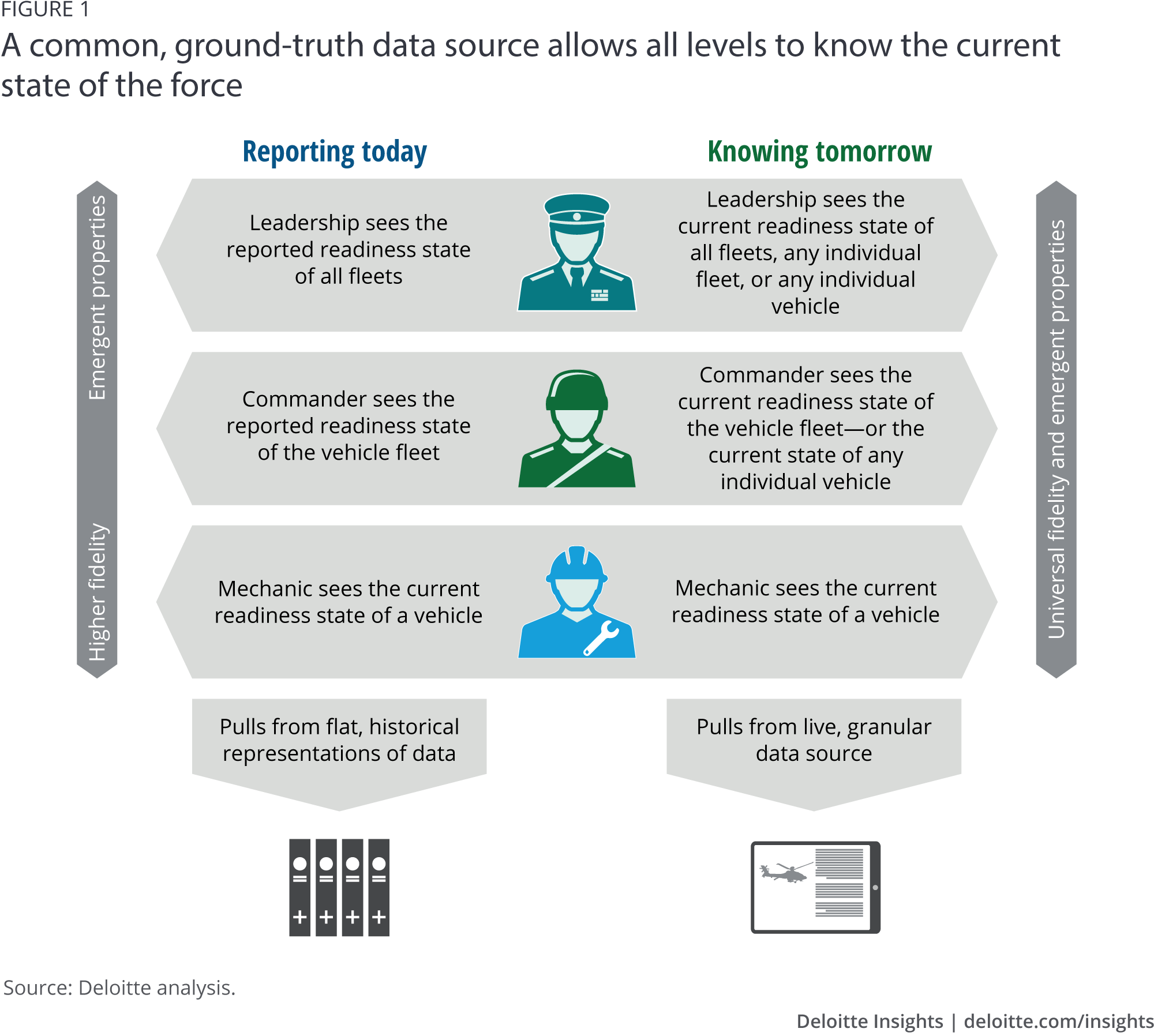
Military technology advances enable “ready anywhere” mentality Military readiness and adaptivity improving across the globe
11 minute read
02 August 2019
Readiness can mean different things to different nations, but every agency in every nation needs to know: “Are we ready?” Here's how Industry 4.0 technologies can help create that picture.
A category 5 typhoon is churning the Philippine Sea into towering 20-foot waves. On the bridge of his cutter, a Philippine coast guard captain needs to know which international ports within a few hours’ sail can accommodate his vessel and shelter it from the strong southeasterly winds.
Learn more
View the Aerospace & defense collection
Explore the Government and public services collection
Subscribe to receive related content from Deloitte Insights
Download the Deloitte Insights and Dow Jones app
A Metropolitan Police sergeant is investigating a burglary in London. She has found a witness to the crime, but the witness only speaks Urdu. With the staff translator tied up on another case, questioning has been painfully slow. She knows many other officers speak Urdu, but she needs to know if there are any within two miles that are free to help right now; if it takes much longer, important leads will be lost.
A German tank commander looks over a field of Leopard 2 tanks. A major NATO training exercise is coming up, and over the course of the weeklong exercise, routine maintenance will be impossible. He needs to know which tanks are likely to fail during that period so they can be maintained in advance to ensure no breakdowns mar the training.
These three challenges may sound as different as the countries and the services involved, but they all revolve around a common need—the need to quickly know what capabilities exist to apply to problem. In each case, a leader needs information about an organization’s equipment, personnel, and infrastructure to understand if the organization can meet mission requirements. In a word, each leader is interested in “readiness.”
With different sizes, budgets, missions, and equipment types, every nation’s military and national security organizations face different readiness challenges. But common to all is a need for accurate information about the organization in real time. Today, the technologies of Industry 4.0 can provide that information and allow any military anywhere in the world to meet its own unique readiness challenges.
What is readiness?
The term readiness means different things in different countries or even different organizations—ranging from rapid-response troops waiting on aircraft to dry graphs of maintenance statistics. Even the word “readiness” is not used in all countries, with other terms including “preparedness” and “adaptability.” But no matter the term, no matter the image, the heart of readiness remains the ability of an organization to execute its assigned mission promptly and capably.
Therefore, understanding readiness starts with understanding the basic capabilities of a force: its equipment, people, and infrastructure. Traditionally, the picture of those capabilities was developed through regular reporting on the status of smaller units, aggregated into a readiness picture at successively higher units. However, there are two fundamental problems with such reporting-based approaches to readiness: First, they are fundamentally backward-looking, providing a static picture of the unit’s status in the past when the report was made. Second, they typically provide leaders only with summary views. While many militaries are striving to become more data-driven and “net-centric” in tactical decisions, similar emphasis on data is lacking in institutional decisions. Without the raw data behind readiness summaries, it can be difficult for leaders to weigh alternatives and make informed decisions.
Different countries, different challenges
While the readiness challenge of matching the right equipment, personnel, and infrastructure to the right mission is constant for every military/national security organization across the globe, the vast differences in size, funding, and mission types mean that this challenge can manifest itself in very different ways across countries. Exacerbating this problem is that each facet of readiness—from equipment to personnel to infrastructure—has its own complicating factors.
Equipment
Physical assets and equipment at times can seem the simplest part of all readiness challenges. After all, a helicopter can either fly the required distance of a mission, or it cannot. A tank is either fully functional, or it is not. However, specific circumstances of each military reveal that each can experience very different readiness challenges even with similar assets.
Take the example of a military looking to add a new capability to its force. The seemingly straightforward question of whether the new equipment’s performance statistics predict that it will meet the mission need can look quite different depending on the circumstances. The United Kingdom, for example, is currently procuring a new ballistic missile submarine HMS Dreadnaught. On paper, this state-of-the-art machine meets or exceeds all the mission requirements laid before it.1 However, the complex project has experienced significant cost and schedule overruns, which are a key contributor to the projected shortfall of £7billion–£15billion (US$8.7 billion–$18.7 billion) in the UK defense equipment budget over the next decade.2 In essence, the readiness of the new Dreadnaught comes at the cost of readiness for other existing assets.
While cost and logistical challenges are common across countries, many nations, especially developing ones, face an additional challenge: the scarcity of technical know-how to build military capabilities. This shortage leads some nations to import the majority of military assets. For example, India imports roughly 70 percent of its military assets.3 This means that India may not face the same risks of cost overruns as the United Kingdom does, but its reliance on overseas military equipment manufacturers can further strain supply and maintenance channels already burdened by the introduction of a new capability.
The different readiness challenges continue throughout the service life of equipment. As suppliers go out of business or tooling and dies wear out, militaries across the globe can face a critical challenge of finding and sourcing components for old assets. For example, in 2017 and into 2018, all of Germany’s submarines were down due to a bottleneck in spare parts.4 That left Europe’s wealthiest country without a single submarine to patrol increasingly contested waterways. The challenge of finding adequate spare parts can be even more difficult for countries such as India that rely on military imports and therefore have longer supply lines and less leverage to convince manufacturers to keep making older parts.
Talent
No matter the high technology or precision assets, military conflict eventually comes down to humans making decisions. Unfortunately, most militaries may not be using their greatest asset, their people, to their fullest potential, simply due to a lack of information. Modern defense organizations are huge and complex, often with a workforce of hundreds of thousands, if not millions. Each of those service members has a variety of skills and abilities. Some speak foreign languages, others know the latest software, and still others have special certifications for diving or parachute operations. However, most militaries cannot see the whole picture for any individual. Training information may be captured in one database, language skills in another, and some skills such as a computer coding hobby are not captured anywhere. Without a single source of information about a soldier or sailor, most militaries truly cannot answer how ready their personnel are for any given mission. They struggle to create the best teams of individuals because they do not know what each individual can do.
Apart from deploying existing talent, countries face challenges in attracting, training, and retaining talent. While many militaries face this challenge, the underlying circumstances may vary in each case. For example, despite its large population, India faces a personnel shortage in all three branches of its armed forces as a surging private sector economy is tightening the competition for talent.5
It is challenging for countries to maintain an adequate workforce with a diverse range of skills to fulfill modern mission requirements. For instance, an army engaging in a foreign land needs personnel with native language proficiency, skills to take aerial or satellite imagery and create maps, and other skills such as medical expertise, surveillance, and reconnaissance. The United Kingdom, which is currently facing its biggest staffing shortage in a decade, has 102 trades in the armed services that do not have enough trained personnel.6 For example, the intelligence analyst occupational field currently faces a 26 percent personnel shortfall in the United Kingdom.7
Infrastructure
In many militaries and national security organizations, even seemingly straightforward tasks as knowing the status of infrastructure can be a challenge. This might appear counterintuitive since airfields and buildings don’t move, so it should be easy to know their condition. However, data siloes and a lack of coordination across different organizations can mean that this information may not reach the right decision-makers at the right time. This picture can become even more complicated when considering digital infrastructure such as IT systems or computer software. In today’s digitized battlefield, the systems can be every bit as important—and as vulnerable—as airfields, ports, and roads.
South Korea, for example, is one of the most internet-connected countries, with more than 95 percent of its population online.8 Such connectivity is vital to the economy of a country that is home to a number of leading technology companies. But connectivity can also become a significant source of military risk in times of conflict, as vulnerabilities in hardware and software threaten basic services on which the military relies. While many cyber vulnerabilities threaten every country, others are specific to one country or military. For example, there are 23 known vulnerabilities within Hangul Office, the popular Korean word-processing tool.9 Far from being merely routing maintenance, countering cyber vulnerabilities is an imperative for modern militaries if they wish to remain ready.
The impact of fragmented or vulnerable digital infrastructure can extend far beyond cyberattacks. Even a military with the size and resources of the United States can be hampered by fragmented data scattered across different systems. The US Army, for example, has historically struggled to find reliable data on how often personnel have been away from home, not just for deployments to combat zones but also for training exercises.10 This lack of data can often lead to certain troops or units spending too much time away from home, leading directly to harmful impacts on mission performance and overall readiness.11 Similarly, underreporting inaccuracies can lead units/divisions to think they are less ready than they actually are which can negatively impact strategy and operational planning in crises.
From reporting to knowing
Today’s most digitally mature organizations are already finding a path to readiness. They are using real-time data taken from sensors and analytics that are part of Industry 4.0 and using it to create a real-world picture of projects, performance, and maintenance.12 Some military and national security organizations are recognizing the power of such an approach and using sensor data to fundamentally change how they view readiness.13 Rather than relying on summary reports, leaders at every level, from defense ministry secretaries to mechanics on the flight line, can pull from the same pool of actual data (see figure 1). By filtering and analyzing it, they can get the information they need, whether that is force-training levels or what is broken on a particular jet.

Once organizations have a common real-time, real-world picture of their equipment, personnel, and infrastructure, it is fairly straightforward to compare the current status of the organization with its mission requirements and take action to fill any gaps. While the highest level of effort in readiness today is spent in reporting and assessing, Industry 4.0–enabled readiness can allow decision-makers to move on to higher-level tasks. For example, once a common picture is in place, an organization essentially has a digital twin of itself.14 That digital twin can be used to monitor performance or stress during operations, but it can also be used in advance to do complex scenario planning. Much as a Formula One race team conducts extensive testing with a virtual twin of the car before ever turning up to a race track,15 military units can play through many alternative scenarios, confident that the results will mirror their real-world performance.16
Better information, better decisions
The shift from reporting to knowing is first and foremost about taking a new approach to readiness. But in this new approach of using real-time data, the tools—in this case, the technologies of Industry 4.0—are also important. By using these technologies—already being deployed in many industries—military organizations can potentially achieve significant improvements in every phase of readiness, from understanding the current state of the force, to matching capabilities to given missions, to even understanding where to invest.
Using technology to understand the state of the force
Technologies such as sensors and data management tools can give military leaders an unprecedented real-time view of the state of their forces. No longer must they guess about current readiness based on historical trends or extrapolate from summary statistics. Rather they can see accurate detail down to the individual plane, ship, soldier, or sailor. In fact, as data analytics improve, this accurate view of the force can also extend into the future with solutions such as predictive maintenance.
Many militaries are beginning to implement systems aimed at breaking down data siloes and making information about equipment available in one place. For example, the United Kingdom’s Joint Asset Management and Engineering Solutions (JAMES) aims to quickly identify the availability, condition, ownership, location, and quantity of different types of equipment.17 Platforms such as JAMES are designed to break down barriers between data and can interface with other logistics systems to share data and perform tasks such as ordering parts. While systems such as JAMES or its US cousin the Autonomic Logistics Information System (ALIS) have experienced technical hurdles, they point toward a future where systems can track detailed performance stats such as how many miles a tank has driven or how many rounds its main gun has fired.18
Such detailed data about equipment can be vital when paired with other technologies such as artificial intelligence (AI). AI models can learn from all of that data, seeing what conditions led to failure in the past, and ultimately predict when certain parts are likely to fail and need to be replaced. The UK Royal Navy is experimenting with such an AI predictive maintenance system on its front-line Type 45 destroyers.19 The AI models are able to examine input from thousands of sensors and understand the overall health of the ship and when systems are likely to fail. This allows sailors to take action before the ship breaks, which previous studies have shown saves cost and increases the uptime for systems.20 The ultimate result is more ships at sea, more planes in the air, and more vehicles on the ground, in short, more readiness.
Using technology to match forces to missions
Having a greater understanding of the current status of the force is important for military leaders, but their readiness efforts don’t end there. Leaders must also be able to understand how the force best matches any given mission. This means evaluating both if the force can accomplish the mission as well as which units or even individual personnel would be best to accomplish it.
With military services often having hundreds of thousands of personnel, coordinating all individual knowledge can be daunting. The concept of managing each soldier as an individual is not entirely foreign to militaries. Many NATO countries, for example, have used sensors and even DNA to tailor medical care to the specific individual, learning about the value of individualized care from years of combat experience.21 However, progress on managing a soldier’s operational or professional career at that individual level has been slow—but it is happening. The US Army, for example, is currently introducing its Integrated Personnel and Pay System-Army (IPPS-A), which combines more than 30 existing systems and also allows soldiers to enter their trainings, language skills, and even hobbies to create an all-around picture of their abilities.22 With that picture, leaders are better able to match soldiers to career assignments and operational missions. An infantry soldier who has learned to code Python in her free time traditionally would not have been considered for a project developing software tools for infantry units, but with IPPS-A, leaders can now see that she may, in fact, be exactly the right fit. Putting the right personnel in a situation can make the force more effective even with the same number of troops, a measurable readiness benefit.
Knowing where to invest
Leaders are faced with a huge array of technology and solution choices. They can increase training hours, recruit more troops, upgrade equipment, or conduct more frequent maintenance. Being good stewards of public funds means they are asked to choose the most effective of those options, often with very little data.
Technology can provide much of the data that leaders need to make those decisions, but making effective use of it also requires organizational change. Take the Dutch military, for example. Recently, the Dutch government increased defense spending by €1.5 billion (US$1.67 billion) per year for five years, reversing decades of relatively small budgets.23 However, over the years, the Dutch military has become very adept at saving money, so it now faces the positive challenge of determining how best to spend the new infusion of funding. With the funding’s stated goal of making the Dutch military more adaptable to changing security threats, the military needs to shift from being good stewards of small investments to a more entrepreneurial mode, seeking out and incorporating new technologies, doctrines, and ideas. This shift may mean greater collaboration across Army, Navy, and Air Force, or even with external companies that do not traditionally work with militaries. All of those changes require time and effort, but, if successful, they can help Dutch military leaders choose the right investments and new capabilities that will make a small military even more potent, adaptable, and ready.
Getting started
For an entire military to build up its readiness capabilities can take time. So, regardless of which capability a military chooses to tackle first, a scaled approach to improving readiness can help give tangible benefits and control wild expectations of immediate transformation.
It is not necessary to leap immediately to a single, real-world, real-time picture of readiness across all equipment, personnel, and infrastructure; rather, taking it slowly can actually improve the chances of success.24 A three-step approach to improving readiness can offer immediate gains while helping to manage expectations and navigate unforeseen challenges:
- Resolve. Use proven technologies to address critical gaps in the current force.
- Remodel. Shift from reporting-based readiness to a real-world, real-time picture of readiness for individual capabilities.
- Reimagine. Join the pictures of all capabilities into a single “digital twin” of the force that can both provide detailed real-world performance and accurate scenario analysis to aid mission and budget planning.
Readiness stands at the heart of what every military and security organization is all about: bringing its best forward to protect citizens. With a few new technologies and a new approach to data, every military around the globe can have confidence that it will be ready, anywhere.
Read more about aerospace & defense
-
Aerospace & Defense Collection
-
National security and technology regulation Article5 years ago
-
Special operations forces and great power competition Article5 years ago
-
National security readiness Article5 years ago
-
The smart base Interactive6 years ago
-
Military readiness through AI Article5 years ago













